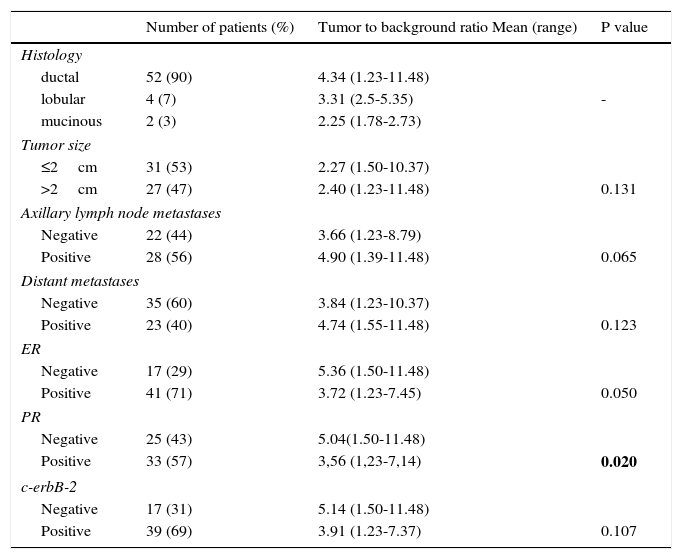The objective of this study was to investigate the relationship between level of 18F-fluorodeoxyglucose (18F-FDG) accumulation in primary breast tumour assessed by positron emission tomography/computed tomography (PET/CT) and histopathological and clinical prognostic factors.
Material and methodsA retrospective analysis was performed using the medical records of 58 female patients (age range: 31-86 years, mean age: 56) with biopsy of proven breast carcinoma, and who had undergone 18F-FDG PET/CT examination before chemotherapy/surgery. The 18F-FDG uptake of breast tumours was calculated as tumour to background ratio (TBR), which was compared with histopathological and clinical prognostic parameters.
ResultsThe histology of the breast tumour in the 58 patients was ductal type in 52 (90%), lobular in 4 (7%), and mucinous in 2 (3%). Tumour size was ≤ 2cm in 31 (53%) patients, and>2cm in 27 (47%). The levels of TBRs were not significantly different between the patients groups with tumours of 2cm or less and greater than 2cm (P=0.131). No significant difference between levels of TBR was observed neither with regards to axillary lymph node involvement (P=0.065) nor in terms of distant metastases (p=0.123). No statistically significant difference was found in levels of TBRs between patients with c-erbB-2 receptor positive and negative ones (P=0.107). Progesterone receptor (PR) expression was observed in 33 patients (57%), and 25 patients (43%) were PR negative. As regards progesterone receptor status, a statistically significant difference was observed in mean TBR levels between patients with and without progesterone receptor expression (P=0.020). Oestrogen receptor expression was positive in 41 (71%) patients, and negative in 17 (29%) patients. The difference in the levels of TBRs between patients with and without oestrogen receptor expression was at the level of significancy (P=0.050).
ConclusionsIt is concluded that 18F-FDG uptake correlates with progesterone negativity of the tumour. However, a significant association with clinical prognostic parameters and level of 18F-FDG uptake levels could not be demonstrated.
El objetivo de este estudio fue investigar la asociación entre el nivel de captación de 18F-fluorodeoxiglucosa (18F-FDG) en el tumor de mama primario, valorado mediante tomografía por emisión de positrones/tomografía computarizada (PET/TC) y correlacionarlo con los factores pronósticos histopatológicos y clínicos.
Material y métodosSe analizaron retrospectivamente las historias clínicas de 58 mujeres (rango de edad: 31-86 años, edad media: 56 años) con biopsia de carcinoma de mama, que se sometieron a una exploración 18F-FDG PET/TC antes de la quimioterapia/cirugía. El grado de captación de 18F-FDG en los tumores de mama se calculó como el índice tumor/fondo (ITF) que se comparó con parámetros pronósticos histopatológicos y clínicos.
ResultadosLa histología del tumor de mama en las 58 pacientes fue de tipo ductal en 52 (90%), lobular en 4 (7%) y mucinoso en 2 (3%). En 31 pacientes (53%) el tamaño del tumor fue ≤2cm y en 27 (47%) fue >2cm. Los niveles de ITF no fueron significativamente diferentes entre el grupo de pacientes con un tumor ≤2cm y el grupo con tumor >2cm (p=0,131). No se observaron diferencias significativas entre los ITF ni con respecto a la afectación de los ganglios linfáticos axilares (p=0,065), ni en términos de metástasis a distancia (p=0,123). Tampoco hubo diferencias estadísticamente significativas en los niveles de ITF entre los pacientes con los receptores de c-erbB-2 positivos y negativos (p=0,107). Treinta y tres pacientes (57%) presentaron receptores de progesterona positivos y en 25 pacientes (43%) eran negativos. Respecto al estado de los receptores de progesterona, se observó una diferencia estadísticamente significativa en los niveles medios de ITF entre pacientes con y sin la expresión del receptor de progesterona (p=0,020). Los receptores estrogénicos fueron positivos en 41 pacientes (71%) y negativos en 17 (29%). Con relación a los receptores estrogénicos, la diferencia en el ITF entre los casos con receptores positivos y los negativos estaba en el nivel de significación (p=0,050).
ConclusionesSe concluye que la captación de 18F-FDG se relaciona con la negatividad de los receptores de progesterona del tumor. Sin embargo, no se demostró una asociación significativa con los parámetros pronósticos clínicos y el grado de captación de 18F-FDG.
Article
If you experience access problems, you can contact the SEMNIM Technical Secretariat by email at secretaria.tecnica@semnim.es or by phone at +34 619 594 780.

Revista Española de Medicina Nuclear e Imagen Molecular (English Edition)









